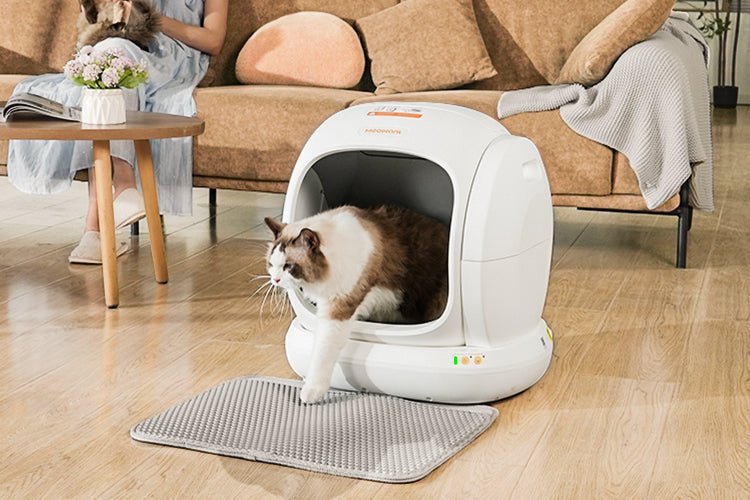Why Do Cats Bury Their Poop?

Have you ever watched your cat meticulously bury its poop and wondered, "Why do they do that?" This quirky feline habit isn't just about cleanliness—it's deeply rooted in their instincts. While most cats naturally cover their waste, some defiantly leave it exposed, leaving owners baffled. So, what's really going on in your cat's mind?
In this article, we'll explore:
✔ The wild instincts behind poop burying.
✔ Why some cats refuse to cover their waste.
✔ How the right litter box setup can encourage better habits.
If you're dealing with litter box issues, I'll also share a smart solution—like the Meowant Self-Cleaning Cat Litter Box (MW-SC01) and Meowant Mixed Cat Litter—that might just change your life (and your cat's too).
Part 1. The Natural Instinct Behind Poop Burying
Cats bury their poop (and pee) for survival-based reasons inherited from their wild ancestors. Here's why:
1. Avoiding Predators & Rivals
In the wild, leaving waste uncovered could attract predators or signal territory disputes. By burying it, cats hide their scent, staying under the radar.
2. Maintaining Cleanliness
Cats are fastidious groomers, and burying waste keeps their living space tidy—a trait that carries over to domestic life.
3. Social Hierarchy
Lower-ranking wild cats bury waste to avoid challenging dominant felines. Your house cat might do the same to avoid "conflict" with you—their perceived "alpha."
Burying poop is normal, but if your cat doesn't, there might be a deeper issue.
Part 2. Why Some Cats Don't Bury Their Poop
Of course, not all cats follow the rulebook. If your cat suddenly stops burying their poop, it's easy to feel confused or even annoyed. But before you blame them, it's worth exploring why this might be happening.
Behavioral Reasons
- Dominance: Unneutered males often leave waste exposed to mark territory.
- Stress/Anxiety: Changes in routine or new pets can disrupt litter habits.
Health Problems
- Arthritis/Joint Pain: Older cats may avoid digging due to discomfort.
- Digestive Issues: Smelly or abnormal stools might make them avoid lingering.
Litter Box Issues
- Dirty Litter: Cats hate filthy boxes—some protest by not covering waste.
- Wrong Litter Type: Texture or scent may discourage digging.
That's where a thoughtful setup can make all the difference. The Meowant SC01 Self-Cleaning Cat Litter Box keeps the box clean with zero effort from you, reducing litter aversion. Pair it with the Meowant Mixed Cat Litter, which is soft on the paws and ultra-absorbent, and you might just solve the mystery of the unburied poop.
[[推荐商品1]]
Part 3. How to Encourage Proper Burying Behavior
If your cat has decided that burying their business is optional, it's time to troubleshoot. Here's how to turn your feline into a tidy, waste-covering pro.
1. Choose the Right Litter Box
- Size: Should be 1.5x your cat's length (nose to tail base). Too small = no burying; too large = intimidating.
- Entry Style: Older cats need low-entry boxes (under 3 inches); kittens may need high sides to contain enthusiastic digging.
- Location: Quiet but accessible - not next to loud appliances or in high-traffic areas.
Number of Boxes: The cat math is simple: number of cats + 1. So 2 cats? 3 boxes.
Pro Solution: The Meowant Self-Cleaning Litter Box (MW-SC01) eliminates guesswork with automatic cleaning after each use, encouraging consistent burying behavior.
2. Use the Best Cat Litter
Not all litters are created equal. Your cat's paws are sensitive, and their preferences might surprise you.
- Texture Matters: Most cats prefer fine, sand-like textures over large pellets.
- Depth: 2-3 inches is ideal - enough to dig but not so deep it's overwhelming.
- Unscented Wins: Strong perfumes can repel sensitive feline noses.
- Clumping Power: Quick-clumping litter makes covering easier.
- Our Pick: Meowant Mixed Cat Litter combines the best of both worlds - excellent odor control with a texture cats love, plus minimal tracking.
3. Keep It Clean (Like, Really Clean)
Imagine being forced to use a filthy porta-potty every day. That's how your cat feels about a dirty litter box.
- Scoop Frequency: At least 1-2 times daily. Yes, really.
- Deep Cleaning: Weekly washes with mild soap (no harsh chemicals).
- Full Replacement: Completely change litter every 2-4 weeks.
- The "Nose Test": If you can smell it, it's way past time to clean.
- Lazy Pet Parent Hack: Self-cleaning boxes like Meowant's do the scooping for you, maintaining constant cleanliness.
4. Rule Out Stress & Health Issues
Yes, you can actually train your cat to bury better.
- The Demonstration Technique: Gently take your cat's paw and show the digging motion (do this when they're calm).
- Reward System: Praise and treats when they bury properly.
- Avoid Punishment: Never scold - it creates litter box aversion.
- Stress Reduction: Provide hiding spots and vertical space if multi-cat tension exists.
Conclusion
Encouraging proper burying behavior comes down to understanding your cat's instincts and preferences. With the right box setup, proper litter choice, consistent cleanliness, and attention to potential health issues, you can transform even the most stubborn non-burying cat into a litter box pro. And for maximum convenience with minimal effort, smart solutions like the Meowant Self-Cleaning Litter Box can make everyone's life easier - because a fresh-smelling home is a happy home for both you and your feline friend.
